Collaborative learning in Artificial Intelligence (AI) is a whirlpool of innovation that melds the capability of systems to learn in more human-like ways, interacting not only with isolated data but also with each other, in a process of strong synergy and constant evolution. From a technological standpoint, these collaborative systems represent a spearhead in achieving more robust and efficient AI. Below, we will delve into the technical elements that comprise this learning modality, its most recent advancements, and the implications in various fields.
Foundations of Collaborative Learning in AI
At its core, collaborative learning relies on the idea that multiple intelligent agents can interact and learn from each other to solve complex problems. This approach distinguishes itself from more traditional methods of machine learning, where a single model learns from a static dataset. It’s the difference between learning in silos and learning in an interconnected community.
Key Developments and Algorithms
Federated neural networks emerge as a crucial advancement in this domain. Through them, it’s possible to distribute the learning process of a model across multiple devices or nodes, which later consolidate their findings without the need to directly share the underlying data. This not only enhances the scalability of learning but is also fundamental for preserving data privacy and security.
Multi-agent optimization, on the other hand, opens doors to unprecedented exploration and adaptability. Evolutionary algorithms, for instance, allow each agent to develop strategies by emulating natural processes such as selection, mutation, and genetic recombination, thereby achieving collaborative incremental improvement.
Emerging Practical Applications
The applications of this learning model are vast and notably impactful, from autonomous vehicles that collectively learn to maneuver with precision, to healthcare systems that improve their diagnoses by integrating learnings from various sources without compromising patient privacy.
In the financial sector, collaborative systems provide a robust framework for fraud detection and risk management by integrating information from multiple entities to create more precise anti-fraud models than if they operated on isolated bases.
In collaborative robotics, for example, robots learn complex tasks like construction or manufacturing from observing and interacting with their robot and human peers. Collaborative learning enables them to share skills and adapt to dynamic environments with unparalleled efficiency.
Challenges and Future Outlook
The process of standardization and regulation in the implementation of these technologies presents a significant challenge. The need for common protocols for communication and knowledge exchange is critical, and, simultaneously, ethical issues arise regarding decision-making in such interconnected systems.
Technically, the challenge lies in achieving a balance between individual learning capacity and the effectiveness of the collective system, maximizing the potential for continual development without falling into conflicts that may arise from opposing interests or redundancies.
Looking to the future, it is plausible to anticipate AI that not only collaborate with each other but also with humans at higher levels of cooperation. A horizon is projected where these technologies enable humans to further narrow the relationship with machines, actively participating in their learning processes and decision-making.
Conclusions
Collaborative learning in AI represents an exciting and essential frontier in the development of adaptive intelligent technologies. It harbors the promise of smarter and more autonomous systems that can radically transform how we interact with our tools and environment, proposing innovative solutions to increasingly complex challenges.
Deepening these concepts and their practical application requires a multidisciplinary approach that calls upon experts in computing, ethics, legislation, and specific applied domains. We are witnessing the construction of a learning ecosystem where collaboration between machines and between humans and machines redefines our capabilities and broadens our intellectual and technical horizons.
This glossary is a representative sample of the interdisciplinary potential and beacon of possibilities that collaborative AI offers. In a constant dialogue with past advancements and with an eye on the horizon of tomorrow, this compendium is not just a record of what is possible today but a map for the future we are beginning to navigate together.






















